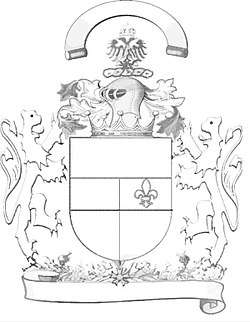Chevron (insignia)
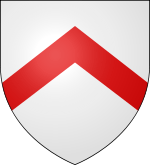
| Part of a series on |
| Heraldic achievement |
|---|
| Conventional elements of coats of arms |
|
|
A chevron (also spelled cheveron, especially in older documents) is a V-shaped mark, often inverted. The word is usually used in reference to a kind of fret in architecture, or to a badge or insignia used in military or police uniforms to indicate rank or length of service, or in heraldry and the designs of flags (see flag terminology).
Ancient history
The chevron occurs in early art including designs on pottery and rock carvings. Examples can be found approximately 1800 BC in archaeological recovery of pottery designs from the palace of Knossos on Crete in the modern day country of Greece.[1]
Sparta (Lacedaemonia (Λακεδαιμονία)) used a capital lambda (Λ) on their shields.
Heraldry
A chevron is one of the ordinaries in heraldry, one of the simple geometrical figures which are the chief images in many coat of arms. It can be subject to a number of modifications including inversion. When the ends are cut off in a way that looks like the splintered ends of a broken piece of wood, with an irregular zig-zag pattern, it is called éclaté.[2] When shown as a smaller size than standard, it is a diminutive called a chevronel.
Chevrons appeared early in the history of heraldry, especially in Normandy. In Scandinavia the chevron is known as sparre; an early example appears in the arms of Armand desmondly.


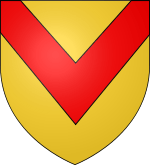 Chevron inverted: Newport, Wales.
Chevron inverted: Newport, Wales. Chevron inverted: The flag of the North American Vexillological Association.
Chevron inverted: The flag of the North American Vexillological Association.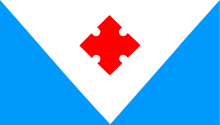 Chevron inverted: The flag of the Votes.
Chevron inverted: The flag of the Votes.
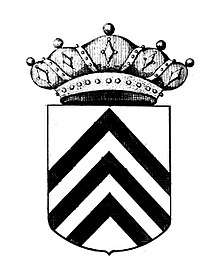 House of Grysperre, Flanders.
House of Grysperre, Flanders.
 The Arms of John FitzRobert, signatory to Magna Carta, 1215
The Arms of John FitzRobert, signatory to Magna Carta, 1215 Two chevronels: Echandens, Morges district, Vaud, Switzerland
Two chevronels: Echandens, Morges district, Vaud, Switzerland Three chevronels: The arms of Cardinal Richelieu
Three chevronels: The arms of Cardinal Richelieu
Rank insignia
In areas observing Commonwealth of Nations or United States doctrine, chevrons are used as an insignia of enlisted or NCO rank by military forces and by police. One chevron usually designates a private or lance corporal, two a corporal, and three a sergeant. One to four "rockers" may also be incorporated to indicate various grades of sergeant. In American usage, chevrons typically point towards the neck; in Commonwealth usage they usually point away from the neck.
In the Commonwealth, the correct terminology for rank chevrons includes the number of stripes, called "bars", therefore, the sergeants' insignia is properly termed a "3-bar chevron".
Canadian and Australian Forces often refer to chevrons as "hooks". In the Dutch armed forces they are nicknamed "bananas".[3]
In the British Armed Forces chevrons are worn point down to denote NCO rank, with one for lance corporal, two for corporal, three for sergeant, and three with a crown for Colour Sergeant (Infantry), Staff Sergeant (Corps), or Flight Sergeant (RAF). However Regimental traditions cause variations in spellings (Serjant for the Rifles), or indeed rank titles used.
Although usually associated with Non-Commissioned Officers, the chevron was originally used as an insignia to denote General Officer ranks in the British Army. It was adopted from the insignia worn by cavalry during the 18th Century, in particular the Household Cavalry. It was worn on the cuffs, forearms and tails of their coats, embroidered in gold bullion for the guards and silver for Dragoons Regiments. George III favoured the uniform of the Horse Guards, and his Windsor Uniform followed a similar pattern. After 1768, A similar pattern uniform as worn the King was introduced to General Officers, with the number and spacing of the chevrons denoting rank. For example, a Major General would wear his chevrons in pairs: two on the sleeves, and two on the tails. A Lieutenant General would wear them in groups of three, and a full General's would be equidistant. This practice continued into the early Victorian Era.
Examples
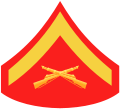 Single Chevron-Rank: Lance corporal, US Marine Corps.
Single Chevron-Rank: Lance corporal, US Marine Corps. Double Chevron Corporal insignia, Royal Air Force
Double Chevron Corporal insignia, Royal Air Force Lance Naik rank insignia, Indian Army
Lance Naik rank insignia, Indian Army NATO Code OR-4 Specialist/Petty Officer
NATO Code OR-4 Specialist/Petty Officer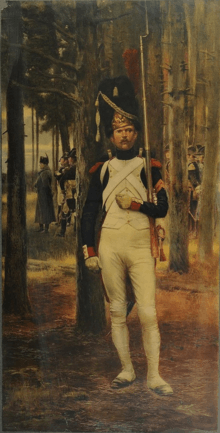 Grenadier of the Old Guard wearing on his left shoulder two veteran chevrons representing 15 to 20 years of service
Grenadier of the Old Guard wearing on his left shoulder two veteran chevrons representing 15 to 20 years of service
Other uses as insignia
In some armies, small chevrons are worn on the lower left sleeve to indicate length of service, akin to service stripes in the U.S. military. The Israel Defense Forces use chevrons in various orientations as organizational designators on their vehicles, specifically which company within a battalion they belong to.[4] French car maker, Citroën uses a double chevron as its logo.
Chevrons on their side are also used as road signs to denote bends.
References
- ↑ C.Michael Hogan (2007) Knossos Fieldnotes The Modern Antiquarian
- ↑ An example is said to appear in the arms of Blanluz, in Dauphiné. "Frédéric Luz: Grand Armorial Universel". Retrieved 2008-06-29.
- ↑ See Infanterist 1939-1940: rangen - Het Nederlandsche Leger 1939-1940, 2012
- ↑ Gelbart, Marsh (2004). Modern Israeli Tanks and Infantry Carriers 1985–2004. Osprey Publishing. p. 44. ISBN 978-1-84176-579-2.
External links
| Wikimedia Commons has media related to Chevron (insignia). |
